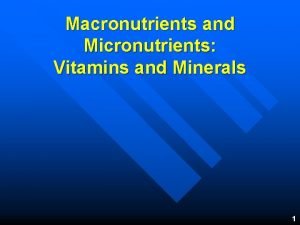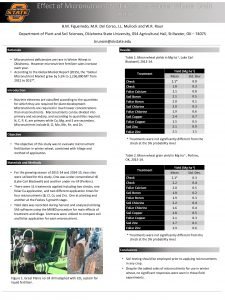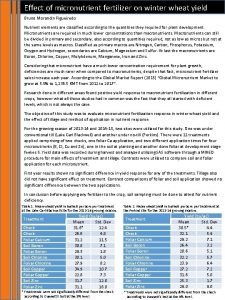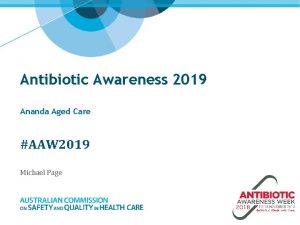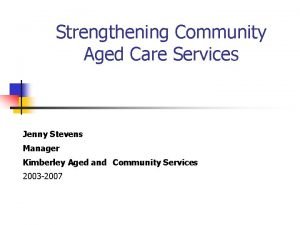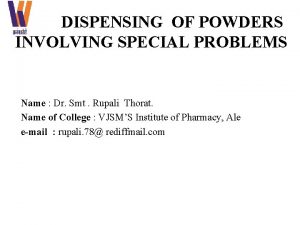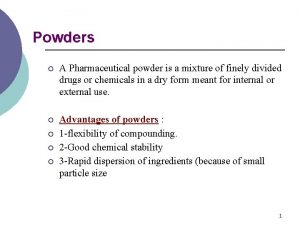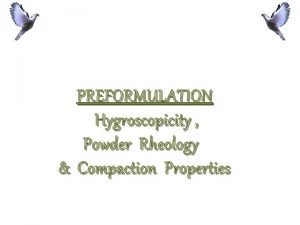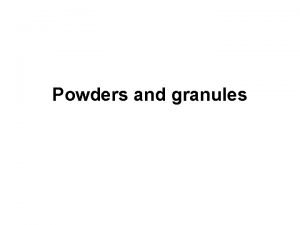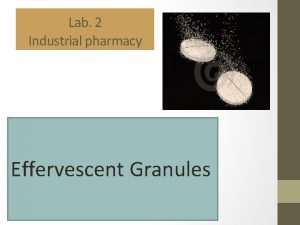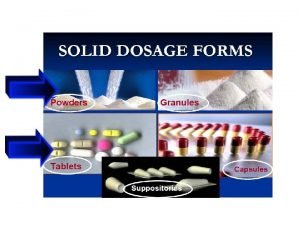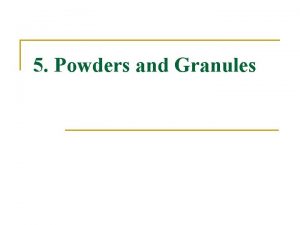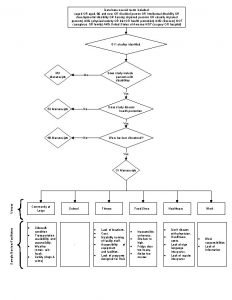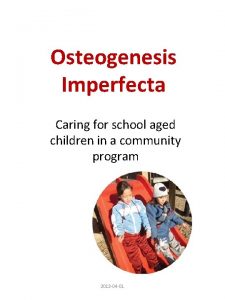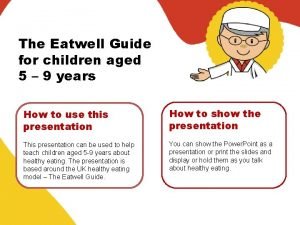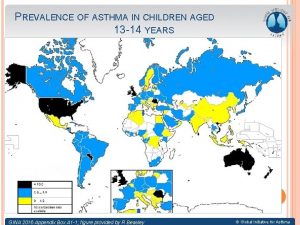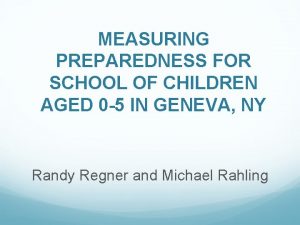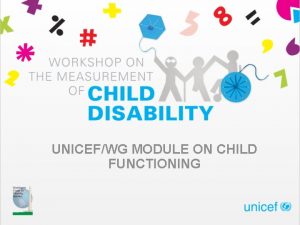Pointofuse fortification with micronutrient powders for children aged




























- Slides: 28

Point-of-use fortification with micronutrient powders for children aged 6 -23 months

Outline �Background �Current Micronutrient Situation �Under five Micronutrient Deficiencies (KNMS 2011) �Why point-of-use fortification? �Supportive policy environment and Legal framework �Home fortification Policy information �Approaches used to Address Micronutrient Deficiencies �Achievements and progress

Background � Global evidence has shown that point-of-use fortification of foods with MNPs is an effective intervention to reduce anaemia and ID in children 6 -23 mos (De-Regil L et al, 2011) � In developing countries every second pregnant woman and about 40% of preschool children are estimated to be anaemic (WHO, 2012) � Malnutrition in all its forms threatens the achievement of the Sustainable Development Goals by 2030 (WHO 2019) � Malnutrition increases the risk of morbidity and mortality contributing to close to half of all deaths in children under five years

Background cont’d �WHO's mandate is to assess the micronutrient status of populations, monitor and evaluate the impact of strategies for the prevention and control of micronutrient malnutrition, and to track related trends over time (https: //www. who. int/vmnis/en/2020) �The Vitamin and Mineral Nutrition Information System (VMNIS), was established in 1991 following a request by the World Health Assembly to strengthen surveillance of micronutrient deficiencies at the global level

Background Cont’d �Systematically retrieve and summarize data on vitamin and mineral status of populations �Provide Member States with up-to-date national, regional, and global assessments of the magnitude of vitamin and mineral deficiencies �Track progress towards the goal of eliminating major vitamin and mineral deficiencies �Provide tools and resources to support efforts of Member States and their partners for assessing vitamin and mineral nutritional status in populations

Current micronutrient situation • Micronutrient deficiency is widespread in the industrialized nations, but even more so in developing countries • It affects all age groups, with the vulnerable groups being at higher risk of developing micronutrient deficiencies • Micronutrient deficiency has many adverse effects on human health • • Direct health effects e. g. rickets, anemia Implications on economic development and productivity particularly in terms of the potentially huge public health costs and the loss of human capital formation

Micronutrient Status in Kenya �Kenya experiencing triple burden of malnutrition; undernutrition(stunting, underweight and wasting), over nutrition and micronutrient deficiency � 41% had an adequately diverse diet ( KDHS, 2014) �Only 22% of the children 6 -23 months old received the Minimum Acceptable Diet � 33% of children age 6 -23 months consumed foods rich in iron the day or night preceding the survey

Micronutrient Status Cont’d �The most common MDs include vitamin A deficiency (VAD), iron deficiency anaemia (IDA), iodine deficiency and zinc deficiency �Together, these affect at least one third of the world’s population, the majority of whom are in developing countries Iron deficiency is the most prevalent. It is estimated that just over 2 billion people are anaemic Just under 2 billion have inadequate iodine nutrition 254 million preschool-aged children are vitamin A deficient (WHO, 2012)

Status Cont’d �Out of all children 6 -59 months, 83. 3% had low plasma zinc, which is an indication of zinc deficiency among pre-school children � 1 out of every 4 (26. 3%) suffers from anemia � Vitamin A Deficiency (VAD) affects 1 out of every 10 (9. 2%) children � 1 out of every 2 (52. 6%) children are at risk of VAD (Marginal) � Zinc deficiency affects 8 out of every 10 (81. 6%) children �Anaemia prevalence of 20% or higher for 6– 23 months give MNPs

Under five Micronutrient Deficiencies (KNMS 2011) �Vitamin A deficiency (under five) : 9. 2 % �Iron Deficiency (under five) : 73 % �Zinc Deficiency (under five) : 51 % �Iron Deficiency Anemia (women): 55%

Why point-of –use fortification? High Prevalence of Micronutrient Deficiencies – Major Direct Cause: Inadequate micronutrient intake

Reasons for low micronutrient intake �Low dietary diversity (Affordability & availability) �Complementary foods (too low nutrient-content, and density; too early introduction) (watery porridges, foods with limited nutrient-content) �Inadequate micronutrient status of pregnant & lactating women (inadequate intake for the child) �Poor bioavailability of micronutrients (absorption inhibitors, especially in plant-source based diet)

Importance and rationale of fortification �Strategy to improve the nutrient content of foods by compensating for lack of dietary diversity �MNPs are also essential for increasing immunity, physical growth strength �promoting good cognitive development and Productivity

Rationale Cont’d �Micronutrient Powder (MNP) are sachets with dry powder of 15 micronutrients that can be added to any semi-solid food ready for consumption �Improves the nutritional quality of the diet when added immediately before consumption �Can also occur outside the home; such as schools or child care facilities

Supportive policy environment and Legal framework � World Health Organization (WHO) guidelines on point-of- use fortification with MNPs � The Constitution of Kenya, 2010 (Articles 43 & 53) � The Kenya Nutrition Action Plan (KNAP), 2018 -2022 � National Social Marketing and communication strategy for food fortification (2015) � National Policy Guideline on Home Fortification with MNP for Children 6 -23 Months in Kenya, 2013 � Operational Guidelines for Health Workers in Kenya: Home Fortification with Multiple Micronutrient Powders, 2016 � National Baby Friendly Community Initiative (BFCI) Trainers’ Guide, 2018 � National MIYCN Policy Guidelines (Draft, 2020)


Approaches used to Address Micronutrient Deficiencies �Dietary diversification- consuming varied food groups for necessary micronutrients in adequate amounts & Biofortification - improvement of nutritional quality of food crops during production �Supplementation – taking vitamins and minerals in different forms �Mass fortification - addition of micronutrients to commonly consumed foods �Public Health Measures- improved sanitation, malaria control and treatment, routine deworming, education & counseling

Summary achievements �The Ministry of Health commitment to address the triple burden of malnutrition as outlined in the KHP (2014 -2030) and National Food and Nutrition Security Policy, 2012 �Developed Point-of-use fortification with Micronutrient Powder Manuals to guide HCP & CHVs �MNPs now in the KEML, June, 2019 passed and included in the WHO guideline �KHIS-Aggregate captures MNPs as one of the important nutrition indicators

Cont’d achievements • Kenya signing up to “Scaling Up Nutrition” (SUN) in November 2012, demonstrating the Government’s commitment in eradicating hunger and malnutrition • The Government is also committed to ensuring equitable access to and uptake of High Impact Nutrition Interventions (HINI), stipulated in the National Food and Nutrition Security Policy gazetted in 2012 • KNAP 2018 -22 launch and adaption by counties in via CNAPs

Expected progress �Country wide capacity building of frontline Health Care Providers �Improved micronutrient status and reduced vitamin and mineral deficiencies -achieving Kenya’s Vision 2030 and the Sustainable Development Goals �Integration of nutrition interventions into national UHC plans; and to progressively expand the list of available nutrition actions as more resources become available

Content of Manuals �Session 1: Course Introduction �Session 2: Background on Micronutrient Deficiencies �Session 3: Role of Point-of-Use Fortification With MNPs in Infant and Young Child Nutrition �Session 4: Point-of-Use Fortification with MNPs �Session 5: Commodity Management and Reporting on MNPs �Session 6: Role of Social and Behaviour Change Communication in Improving the Uptake of MNPs �Session 7: Action Planning

MNP Sachet

Composition in 1 gm sachet Vitamin A 400 μg RE Vitamin D 5 μg Vitamin E 5 mg Vitamin C 30 mg Vitamin B 1 (Thiamine) 0. 5 mg Vitamin B 2 (Riboflavin) 0. 5 mg Vitamin B 3 (Niacin) 6 mg Vitamin B 6 (Pyridoxine) 0. 5 mg Vitamin B 12 (Cobalamin) 0. 9 μg Folate 150 μg Iron 10 mg Zinc 4. 1 mg Copper 0. 56 mg Selenium 17 μg Iodine 90 μg





COMBAT HIDDEN HUNGER FOR A HEALTHY AND PRODUCTIVE NATION
 Define divided powders
Define divided powders Premix for fortification
Premix for fortification Medolac
Medolac Food delivery fortification
Food delivery fortification Types of vitamins
Types of vitamins +micronutrient +fertilizer +wheat
+micronutrient +fertilizer +wheat +winter +wheat +micronutrient
+winter +wheat +micronutrient Dignity of choice
Dignity of choice Ananda aged care
Ananda aged care Open disclosure in aged care
Open disclosure in aged care 5 principles of cultural safety
5 principles of cultural safety A case of murder by vernon scannell
A case of murder by vernon scannell My aged care
My aged care Kimberley aged care services
Kimberley aged care services Nettles by vernon scannell analysis
Nettles by vernon scannell analysis For a moment the last sunshine fell with romantic affection
For a moment the last sunshine fell with romantic affection What is cultural safety in aged care
What is cultural safety in aged care Aged care matters
Aged care matters Deliquescent powders
Deliquescent powders Powder flowing angle
Powder flowing angle Contoh serbuk gigi
Contoh serbuk gigi Surgical dusting powder example
Surgical dusting powder example Jolting volumeter
Jolting volumeter Granulated powder
Granulated powder Mystery powders lab
Mystery powders lab Site:slidetodoc.com
Site:slidetodoc.com Milk powder bulk density
Milk powder bulk density Finely divided, bulk effervescent
Finely divided, bulk effervescent Bris för vuxna
Bris för vuxna




